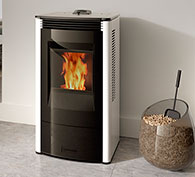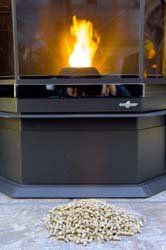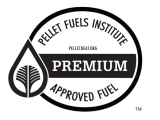Pellet Stoves
On this page:
What is a Pellet Stove?

Pellet stoves look similar to wood stoves, but they are typically cleaner and more efficient. Pellet stoves use compressed pellets, made from ground, dried wood or other biomass for fuel. To create heat, the pellets are poured into a hopper, which automatically feeds into the stove. You can use a pellet stove to supplement your existing home heating system or as your sole heat source.
Pellet stoves can be freestanding or stove inserts. Freestanding stoves vent through an external wall or ceiling, while inserts can use your existing chimney.
Pellet stoves also come in two types, which are based on the pellet delivery system, top-fed or bottom-fed.
- A top-fed pellet stove directs pellets into a combustion chamber from a hopper at the top of the stove. The combustion chamber is more likely to be filled with ash and other debris than in a bottom-fed stove.
- A bottom-fed pellet stove feeds pellets into the combustion chamber from the bottom and automatically pushes ash into the ash pan.
Of the available biomass technologies, pellet stoves are among the easiest to operate and maintain. Unlike wood stoves, pellet-burning involves less hauling and no cutting, splitting, stacking or waiting for your wood to dry. If used correctly, pellet stoves produce very little smoke or creosote, which is the main cause of chimney fires.
Pellets

Wood pellets are normally manufactured from wood and byproducts like sawdust, wood chips, paper and bark. Some pellet stoves only accept wood-sourced pellets, while others can burn other biofuels, like corn or nutshells.
The pellets are manufactured to be very dense, which helps them to burn very hot and clean, reducing smoke and waste gases. Pellets can differ significantly in how well they’re made and how well they burn. Lower quality pellets may provide less heat and create a fine dust. Higher quality pellets tend to burn cleaner and produce less ash.
In the U.S., a third-party accreditation from the PFI Standards Program allows pellet stove users to identify consistent, reliable pellets. The pellet producers are also subject to regular third-party facilities inspection and lab testing. Other pellet certification programs include ENplus, which is based on the EU standard for wood pellets, and CANPlus, a Canadian program. Note that many pellet stove manufacturers recommend only using pellets from qualified producers.

Pellet stoves need an electrical supply to work because they use motorized components to feed the fire and blow out hot air. You can buy backup batteries with some models. Some stoves use gravity to feed the burn box instead of electricity. These gravity stoves are less common but do not require electricity in order to provide heat.
Efficiency and Maintenance
Pellet stoves need to be regularly cleaned to ensure that the stove runs efficiently and safely. Additionally, you should have your stove professionally cleaned at least once a year. For best maintenance practices for your appliance, consult the owner's manual before operating your stove.
EPA-certified pellet stoves usually fall into the 70-83% efficiency range, while heating capacities range from 8,000-90,000 Btu per hour. EPA currently certifies over 90 different pellet stoves. Find the one that best fits your needs at the EPA-certified woodstove database by searching for “pellet stove.”
